The seven best USB microphones under $130
(Posted on September 07, 2016 by Admin)
We’re getting asked a lot how to improve recording quality. If there’s some knob or AU plugin that can make a bad recording into a good one. And we always reply: Get a good USB microphone. But which one? Well, read this blog post…
The list is at the end of the article - Click here to jump straight to the list if you just want to know which mic to buy!
Getting a good microphone is the only way to significantly improve recording quality!
There are many ways to improve audio quality of your recordings but no other way makes that big a difference as
buying a decent microphone. Back in the day this used to be quite an endeavor. Besides the microphone you
also had to have a decent pre-amp and a soundcard with a nice analog-to-digital converter. Nowadays you can get all of these things bundled in a USB microphone without breaking the bank.
The most important thing to ask yourself when buying a microphone is what you’re going to use it for. Price isn’t the only difference in microphones and nowadays you’ll often find that it doesn’t even matter anymore. There are a lot of great microphones for little money out there but before telling you what those are let us first have a look at some microphone basics.
The different kinds of microphones
No matter what kind of microphone, they all work according to one simple principle: take in sound and convert it to an electric signal. To do so there are two main methods: either use induction (dynamic microphones) or capacitance change (condenser microphones).
Dynamic Microphones
Dynamic microphones have one major feature: They are quite sturdy and have a high tolerance for loud sounds (high SPL value). That is the reason you see them so often in live situations.
Ribbon Microphones
Ribbon Microphones have a tendency to soften and warmen incoming sound. That’s why they are usually used in studios for instruments as well as voice recordings. (Also they really really break easily. So you don’t want to move them around!)
Condenser Microphones
Condenser Microphones are excellent for recording voices. They are also often used as all purpose microphones and the majority of USB mics are condenser microphones.
Small-Diaphragm Condenser Microphones
Small diaphragm condenser microphones do especially well at recording higher frequencies and sound sources that change quickly in volume and/or have a sudden attack. This is more of a special use case and you won’t find many USB microphones built this way.
Microphone characteristics
Every microphone is different. Which makes it good for some use cases and bad for others. Learn in this section more about microphone characteristics.
Polar Patterns
A microphones polar pattern describes how well the microphones responds to sounds coming from different directions. For example a microphone with a omnidirectional polar pattern records audio from all directions. While a unidirectional one “hears” only sound from one direction.
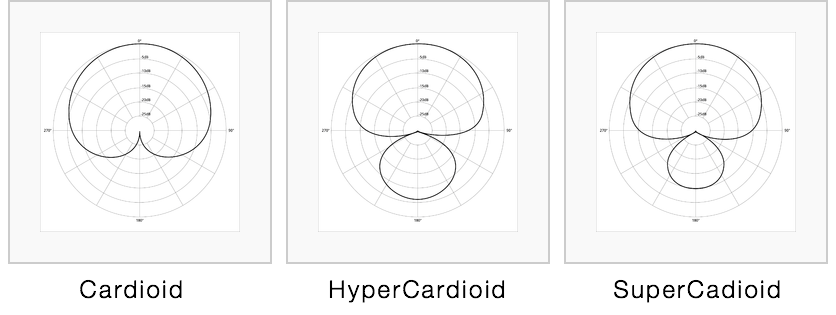
The cardioid pattern has a heart shape.
This makes the microphone sensitive to
sound coming from the side or from
straight on, but makes the mic ignore
anything coming from its back.
The hypercardioid is more sensitive
to sound from the back, but ignores
everything coming from a 90 or 270 angle.
The supercardioid mic accepts a little
sound from the back, but rejects more
from the sides.
Unidirectional microphones are the most common type and they come in three flavours: Cardioid, Supercardioid and Hypercardioid. All three reject (to a certain degree) any sound coming from behind or from the sides. This comes in handy when you’re using the mic in a noisy environment, like miking a vocalist in a band.
There are also so called multi-pattern microphones. These mics offer a way to switch from one polar pattern to another. (e.g. from cardioid to bi-directional).
Frequency Response
Frequency Response refers to the range of frequencies a microphone will pick up. It usually is referred to by its lowest and highest frequencies. For instance when you’re planning on recording spoken language, singing or generally voices you’d be looking for a microphone having a frequency response from 80Hz to 15kHz.
It is important to note that frequency response alone is not sufficient to fully describe a mics ‘character’. There’s also the response curve which shows how well the mic is going to pick up different frequencies. Usually this is referred as ‘colouring the sound’.
A completely flat curve leads to a 100% honest reproduction of audio while a curve having peaks in the midfield increases intelligibility of voices. Peaks in the low end on the other hand help your bass guitar being heard but muddy up your voice recordings and peaks on the other end of the spectrum increase presence of whatever you’re recording.
The Proximity Effect
Did you ever notice how your voice changes the closer your mouth gets to a microphone? That’s the proximity effect. It’s an important characteristic of any microphone.
The Proximity Effect causes bass frequency to become more pronounced the closer the sound source gets to the mics diaphragm. Usually it is more noticeable with condenser mics.
The seven best USB Microphones
All microphones on this list are great. You can’t really go wrong with either of one. So if price is a main concern: Just get the least expensive one. It will be still light years ahead of your headset or built-in microphone! The other concern is mobility: Not all of those microphones are light weight enough for “in the field” duty. So if you need a mobile mic get a model made for that use case.
All prices are taken from the US amazon.com store and in USD currency.
CAD - U37
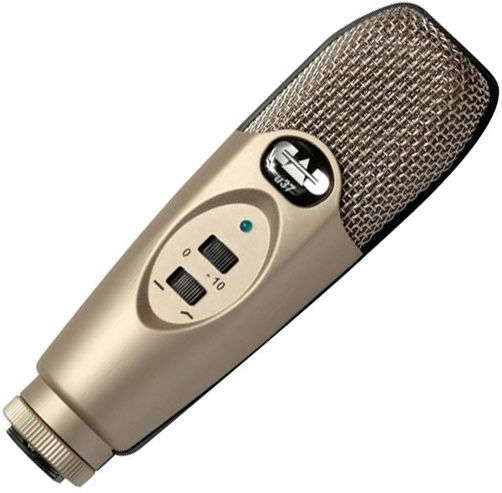
Price:
$39.51
Type:
Large Condenser
Pick-Up Pattern:
Cardioid
BitDepth:
16 bit
Sampling Rate:
48 kHz
Frequency Response:
20Hz – 20kHz
It might not be a beauty queen, but given the price and audio quality it is worth a look. There are a lot of raving amazon reviews out there praising this microphone for vocal and instrument recordings alike and we too think it’s the best choice when you’re on a budget.
Blue Microphones - Yeti
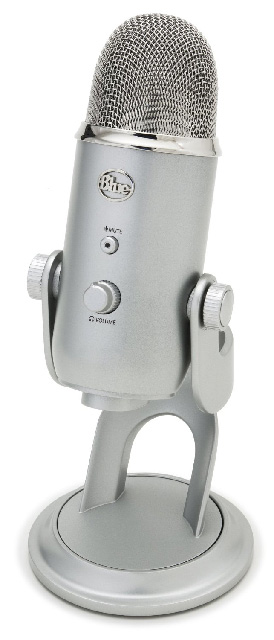
Our favorite: Get this one if you can
Price:
$129.00
Type:
Three Condenser Capsules
Pick-Up Pattern:
Switchable between: Cardioid, BiDirectional, Omnidirectional and Stereo
BitDepth:
16 bit
Sampling Rate:
48 kHz
Frequency Response:
20Hz – 20kHz
SPL:
120dB
The yeti is an easy choice. Wherever you look it gets praised for its pristine audio quality and its features.
You get multiple polar patterns to choose from (cardioid, bidirectional, stereo and omnidirectional), three capsules, a headphone out for monitoring without latency and a dedicated gain control. All of this comes with a little weight and thus the blue yeti isn’t your go to solution for mobile use but besides that it’s probably the single best choice out there.
Samson - Go Mic
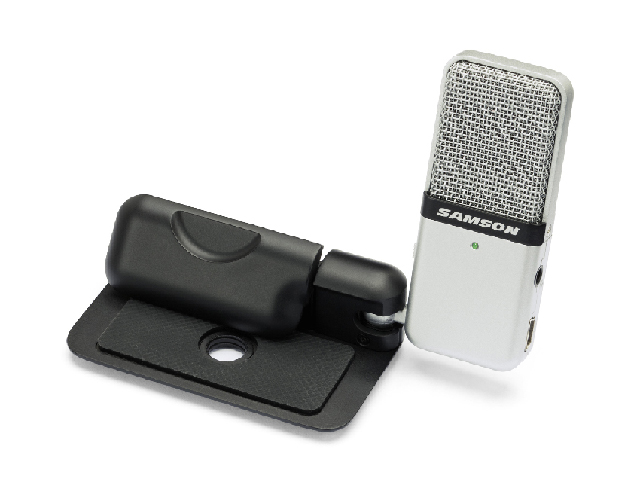
Price:
$39.99
Type:
2 Condenser
Pick-Up Pattern:
Cardiod
BitDepth:
16 bit
Sampling Rate:
44.1 kHz
Frequency Response:
20Hz - 18kHz
Other:
Portable, Headphone Out
A mobile usb mic made for clipping onto your laptop on the go like the name implies. Like the Blue Snowflake it’s a good choice for situations like podcasting while hunting Sasquatch or annoying people in public places.
Blue Microphones - Snowball
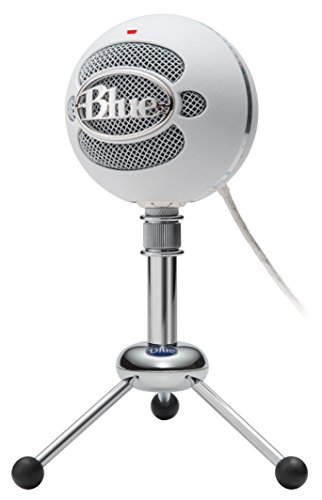
Price:
$69.00
Type:
Condenser
Pick-Up Pattern:
Switchable Pickup Pattern (Cardiod, Omnidirectional)
BitDepth:
16 bit
Sampling Rate:
44.1 kHz
Frequency Response:
40Hz - 18 kHz
If there’s one thing Blue Microphones are good at it’s combining great sound with weird looks. The snowball is no exception. When in a shock mount it does look great though.
Audio-Technica ATR-2100-USB
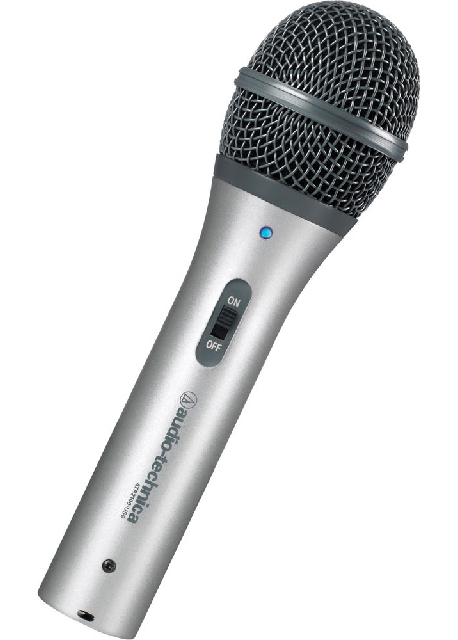
Price:
$79.00
Type:
Dynamic
Pick-Up Pattern:
Cardioid
BitDepth:
16 bit
Sampling Rate:
48 kHz
Frequency Response:
50 Hz - 15 kHz
Other:
USB and XLR output, Headphone Out
The dynamic mic in our list. This mic offers a great sound with the advantage of being a well-balanced handheld microphone. Don’t get confused by its frequency response: unless you’re trying to record sounds on the extreme ends of the human hearing range, this microphone will perform great.
Samson - Meteor
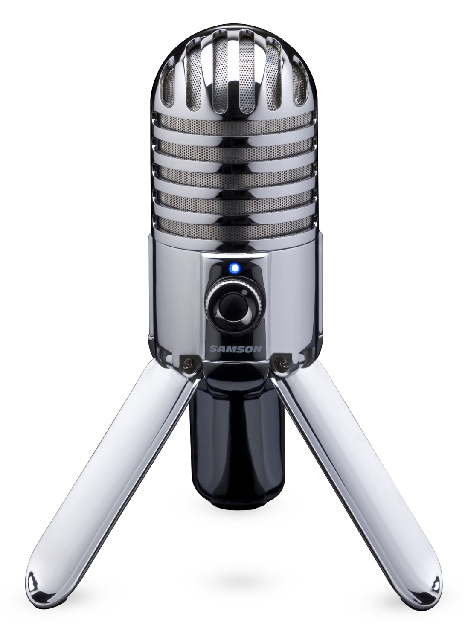
Price:
$69.99
Type:
Condenser
Pick-Up Pattern:
Cardioid
BitDepth:
16 bit
Sampling Rate:
48 kHz
Frequency Response:
20 Hz - 20 kHz
Other:
Headphone Out
Recording with the Samson Meteor produces better than average audio quality in CD Quality. It’s very well suited for voice recordings like singing or podcasting. The only downside to this mic is its stand which at times proved to be a less than perfect solution.
Blue - Snowflake
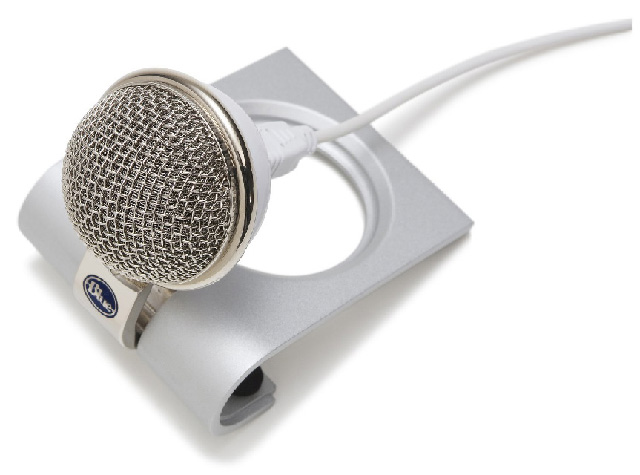
Price:
$49.00
Type:
Condenser
Pick-Up Pattern:
Cardioid
BitDepth:
16 bit
Sampling Rate:
44.1 kHz
Frequency Response:
35 Hz - 20 kHz
The third microphone from Blue on our list and the second mobile model. I suppose given its name it is probably more suited for hunting yetis, but other than that it is not much different from its Samson rival. If you like the look better, go for this one.
Shameless self promotion: Have you tried Vector yet? Vector is an audio editor for OS X that is designed to fit into the space between simple audio apps and full blown studio production tools. (Kinda like Cool Edit Pro for the Mac - if you are that old school).
We’re getting asked a lot how to improve recording quality. If there’s some knob or AU plugin that can make a bad recording into a good one. And we always reply: Get a good USB microphone. But which one? Well, read this blog post…
The list is at the end of the article - Click here to jump straight to the list if you just want to know which mic to buy!
Getting a good microphone is the only way to significantly improve recording quality!
There are many ways to improve audio quality of your recordings but no other way makes that big a difference as buying a decent microphone. Back in the day this used to be quite an endeavor. Besides the microphone you also had to have a decent pre-amp and a soundcard with a nice analog-to-digital converter. Nowadays you can get all of these things bundled in a USB microphone without breaking the bank.
The most important thing to ask yourself when buying a microphone is what you’re going to use it for. Price isn’t the only difference in microphones and nowadays you’ll often find that it doesn’t even matter anymore. There are a lot of great microphones for little money out there but before telling you what those are let us first have a look at some microphone basics.
The different kinds of microphones
No matter what kind of microphone, they all work according to one simple principle: take in sound and convert it to an electric signal. To do so there are two main methods: either use induction (dynamic microphones) or capacitance change (condenser microphones).
Dynamic Microphones
Dynamic microphones have one major feature: They are quite sturdy and have a high tolerance for loud sounds (high SPL value). That is the reason you see them so often in live situations.
Ribbon Microphones
Ribbon Microphones have a tendency to soften and warmen incoming sound. That’s why they are usually used in studios for instruments as well as voice recordings. (Also they really really break easily. So you don’t want to move them around!)
Condenser Microphones
Condenser Microphones are excellent for recording voices. They are also often used as all purpose microphones and the majority of USB mics are condenser microphones.
Small-Diaphragm Condenser Microphones
Small diaphragm condenser microphones do especially well at recording higher frequencies and sound sources that change quickly in volume and/or have a sudden attack. This is more of a special use case and you won’t find many USB microphones built this way.
Microphone characteristics
Every microphone is different. Which makes it good for some use cases and bad for others. Learn in this section more about microphone characteristics.
Polar Patterns
A microphones polar pattern describes how well the microphones responds to sounds coming from different directions. For example a microphone with a omnidirectional polar pattern records audio from all directions. While a unidirectional one “hears” only sound from one direction.

The cardioid pattern has a heart shape.
This makes the microphone sensitive to
sound coming from the side or from
straight on, but makes the mic ignore
anything coming from its back.
The hypercardioid is more sensitive
to sound from the back, but ignores
everything coming from a 90 or 270 angle.
The supercardioid mic accepts a little
sound from the back, but rejects more
from the sides.
Unidirectional microphones are the most common type and they come in three flavours: Cardioid, Supercardioid and Hypercardioid. All three reject (to a certain degree) any sound coming from behind or from the sides. This comes in handy when you’re using the mic in a noisy environment, like miking a vocalist in a band.
There are also so called multi-pattern microphones. These mics offer a way to switch from one polar pattern to another. (e.g. from cardioid to bi-directional).
Frequency Response
Frequency Response refers to the range of frequencies a microphone will pick up. It usually is referred to by its lowest and highest frequencies. For instance when you’re planning on recording spoken language, singing or generally voices you’d be looking for a microphone having a frequency response from 80Hz to 15kHz.
It is important to note that frequency response alone is not sufficient to fully describe a mics ‘character’. There’s also the response curve which shows how well the mic is going to pick up different frequencies. Usually this is referred as ‘colouring the sound’.
A completely flat curve leads to a 100% honest reproduction of audio while a curve having peaks in the midfield increases intelligibility of voices. Peaks in the low end on the other hand help your bass guitar being heard but muddy up your voice recordings and peaks on the other end of the spectrum increase presence of whatever you’re recording.
The Proximity Effect
Did you ever notice how your voice changes the closer your mouth gets to a microphone? That’s the proximity effect. It’s an important characteristic of any microphone.
The Proximity Effect causes bass frequency to become more pronounced the closer the sound source gets to the mics diaphragm. Usually it is more noticeable with condenser mics.
The seven best USB Microphones
All microphones on this list are great. You can’t really go wrong with either of one. So if price is a main concern: Just get the least expensive one. It will be still light years ahead of your headset or built-in microphone! The other concern is mobility: Not all of those microphones are light weight enough for “in the field” duty. So if you need a mobile mic get a model made for that use case.
All prices are taken from the US amazon.com store and in USD currency.
CAD - U37

| Price: | $39.51 |
| Type: | Large Condenser |
| Pick-Up Pattern: | Cardioid |
| BitDepth: | 16 bit |
| Sampling Rate: | 48 kHz |
| Frequency Response: | 20Hz – 20kHz |
It might not be a beauty queen, but given the price and audio quality it is worth a look. There are a lot of raving amazon reviews out there praising this microphone for vocal and instrument recordings alike and we too think it’s the best choice when you’re on a budget.
Blue Microphones - Yeti

Our favorite: Get this one if you can
| Price: | $129.00 |
| Type: | Three Condenser Capsules |
| Pick-Up Pattern: | Switchable between: Cardioid, BiDirectional, Omnidirectional and Stereo |
| BitDepth: | 16 bit |
| Sampling Rate: | 48 kHz |
| Frequency Response: | 20Hz – 20kHz |
| SPL: | 120dB |
The yeti is an easy choice. Wherever you look it gets praised for its pristine audio quality and its features. You get multiple polar patterns to choose from (cardioid, bidirectional, stereo and omnidirectional), three capsules, a headphone out for monitoring without latency and a dedicated gain control. All of this comes with a little weight and thus the blue yeti isn’t your go to solution for mobile use but besides that it’s probably the single best choice out there.
Samson - Go Mic

| Price: | $39.99 |
| Type: | 2 Condenser |
| Pick-Up Pattern: | Cardiod |
| BitDepth: | 16 bit |
| Sampling Rate: | 44.1 kHz |
| Frequency Response: | 20Hz - 18kHz |
| Other: | Portable, Headphone Out |
A mobile usb mic made for clipping onto your laptop on the go like the name implies. Like the Blue Snowflake it’s a good choice for situations like podcasting while hunting Sasquatch or annoying people in public places.
Blue Microphones - Snowball

| Price: | $69.00 |
| Type: | Condenser |
| Pick-Up Pattern: | Switchable Pickup Pattern (Cardiod, Omnidirectional) |
| BitDepth: | 16 bit |
| Sampling Rate: | 44.1 kHz |
| Frequency Response: | 40Hz - 18 kHz |
If there’s one thing Blue Microphones are good at it’s combining great sound with weird looks. The snowball is no exception. When in a shock mount it does look great though.
Audio-Technica ATR-2100-USB

| Price: | $79.00 |
| Type: | Dynamic |
| Pick-Up Pattern: | Cardioid |
| BitDepth: | 16 bit |
| Sampling Rate: | 48 kHz |
| Frequency Response: | 50 Hz - 15 kHz |
| Other: | USB and XLR output, Headphone Out |
The dynamic mic in our list. This mic offers a great sound with the advantage of being a well-balanced handheld microphone. Don’t get confused by its frequency response: unless you’re trying to record sounds on the extreme ends of the human hearing range, this microphone will perform great.
Samson - Meteor

| Price: | $69.99 |
| Type: | Condenser |
| Pick-Up Pattern: | Cardioid |
| BitDepth: | 16 bit |
| Sampling Rate: | 48 kHz |
| Frequency Response: | 20 Hz - 20 kHz |
| Other: | Headphone Out |
Recording with the Samson Meteor produces better than average audio quality in CD Quality. It’s very well suited for voice recordings like singing or podcasting. The only downside to this mic is its stand which at times proved to be a less than perfect solution.
Blue - Snowflake

| Price: | $49.00 |
| Type: | Condenser |
| Pick-Up Pattern: | Cardioid |
| BitDepth: | 16 bit |
| Sampling Rate: | 44.1 kHz |
| Frequency Response: | 35 Hz - 20 kHz |
The third microphone from Blue on our list and the second mobile model. I suppose given its name it is probably more suited for hunting yetis, but other than that it is not much different from its Samson rival. If you like the look better, go for this one.
Shameless self promotion: Have you tried Vector yet? Vector is an audio editor for OS X that is designed to fit into the space between simple audio apps and full blown studio production tools. (Kinda like Cool Edit Pro for the Mac - if you are that old school).
